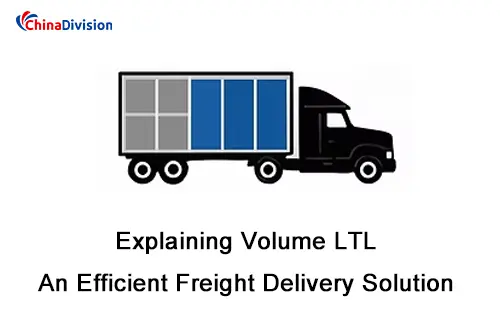Explaining Volume LTL: An Efficient Freight Delivery Solution
In international freight, do you often face this dilemma: your cargo volume isn't enough to fill a full container load (FCL), but traditional less-than-truckload (LTL) shipping is prohibitively expensive, fragile, or time-consuming? Perhaps you need a better third option: volume LTL, also known as shared truckload or partial truckload (TL).
Table of Contents
- What is Volume LTL / Shared Truckload?
- Key Features of Volume LTL (Partial Truckload)
- Volume LTL vs. Standard LTL: What's the Difference?
- Shared Truckloads: A Higher Level of Efficiency
- When should you choose volume LTL service?
- FAQ: Solving Your LTL Shipping Pain Points
- How does Chinadivision improve international freight efficiency with Volume LTL?
Traditional freight methods, such as less-than-truckload (LTL) and full truckload (FTL), often leave shippers stuck with high costs or inefficient space utilization. The emergence of less-than-truckload (LTL) and shared truckload (CO-LON) solutions is revolutionizing the medium-duty freight landscape. These shipments, while smaller than a full truckload, still require greater efficiency than standard LTL.
In this guide, we'll delve into volume LTL, its advantages, key differences from traditional shipping methods, and when to choose it. We'll answer your key questions and help you find the key to cost reduction and increased efficiency in logistics.
What is Volume LTL / Shared Truckload?
Volume LTL (also known as partial LTL) is a hybrid shipping method that combines the cost savings of LTL with the speed and reliability of full truckload. It's an innovative transportation model designed for shipments larger than LTL and smaller than FTL. Through co-loading, it strategically consolidates freight from multiple shippers to similar destinations onto a single truck. Volume LTL is suitable for the following types of shipments:
Weighing between 5,000–20,000 pounds (2.3–9 metric tons).
Occupying 12–24 linear feet of trailer space (or more than six pallets).
Does not require a dedicated truck, but is too large for standard LTL.
Standard less-than-truckload (LTL) shipments are combined with other shippers' shipments and may require multiple transfers. Volume LTL, on the other hand, uses the same truck from origin to destination (with fewer loading and unloading points). This not only shortens transit time and reduces the risk of damage, but also offers more favorable pricing for partial loads than full truckload (FTL).

Simply put, it's like a "rideshare" service in the logistics world. You don't have to pay for a full truckload, but your shipment receives nearly full truckload shipping.
Key Features of Volume LTL (Partial Truckload)
Affordable Medium-Duty Freight
Pay only for the space you use, avoiding the additional charges for unused capacity associated with FTL. Compared to the per-ticket, complex rates of standard LTL, Volume LTL uses space-based pricing. You pay proportionally to the truck space you occupy, which is typically lower than LTL rates for the same weight.
Faster Transit Times
By eliminating unnecessary stops and transfers, Volume LTL offers more direct routes, resulting in faster and more predictable overall delivery times than standard LTL, helping you optimize inventory management.
Reduced Risk of Damage
Less handling means less chance of damage. Your shipment is loaded onto the truck at its origin and unloaded only at its destination, eliminating the multiple loading and unloading and distribution at transit hubs associated with traditional LTL. This significantly reduces the risk of damage and loss due to handling.
Flexible Scheduling
Unlike the rigid FTL schedule, Volume LTL can adapt to subtle changes in pickup/delivery windows. It perfectly accommodates fluctuations in your shipment volume. Whether it's seasonal incremental shipments or regular bulk replenishment, Volume LTL offers a flexible, economical, and reliable solution.
Volume LTL vs. Standard LTL: What's the Difference?
Volume LTL offers direct or minimal transit, loading and unloading, resulting in lower risk of damage and faster, more stable delivery times. Prices are calculated based on the percentage of truck space occupied, with the optimal volume being 6-18 pallets (or 10%-75% of the truck's capacity). It's best suited for medium-sized, time-sensitive shipments.
Volume LTL requires multiple transits, distribution, and loading and unloading, resulting in a relatively high risk of damage. Transit times are affected by the number of transits and can fluctuate significantly. Prices are calculated based on complex factors such as cargo weight, product type, and distance. Volumes typically range from 1 to 6 pallets. It's suitable for small, non-urgent shipments.
Shared Truckloads: A Higher Level of Efficiency
Shared truckloads take volume LTL (less-than-truckload) to a new level, consolidating shipments from multiple shippers into a single full truckload (FTL)-sized shipment for direct delivery to the destination. Here's why:
Maximizes trailer utilization → Reduces unit costs.
Direct routes → No stops, reducing transit time by up to 50%.
Environmentally friendly → Fewer empty miles = Reduced carbon footprint.
When should you choose volume LTL service?
Your shipment is too large for standard LTL but won't fill a single truck.
You need faster delivery than standard LTL, but can't justify the cost of FTL.
Your shipment is fragile and you want to minimize handling (less handling = lower risk).
You have high requirements for shipping timeliness and certainty, and want faster, more direct delivery. (For example, perishable goods, seasonal inventory).
You've been searching for a way to control logistics costs without sacrificing service quality and safety.
FAQ: Solving Your LTL Shipping Pain Points
What are the main challenges of bulk LTL shipping?
The biggest issues are price instability (due to demand fluctuations) and extended shipping times due to frequent handling.
How does bulk LTL reduce damage compared to standard LTL?
Standard LTL involves multiple cross-dock stations, where goods are repeatedly loaded and unloaded. Bulk LTL uses the same truck, minimizing contact points.
Is Volume LTL still suitable for shipments destined for remote locations?
Volume LTL is best suited for shipments destined for a specific area or along a specific route. If your destination is very remote, we need to evaluate whether other shipments can be co-loaded. Chinadivision has an extensive network of resources and can assess the optimal solution (possibly Volume LTL with local delivery) and provide professional advice.
What's the difference between Partial Truckload and Volume LTL?
Both are essentially the same: they both involve shipping less than a full truckload but larger than standard LTL. Different logistics companies may use different terminology (Partial Truckload, Shared Truckload), but the service logic remains consistent.
In the fiercely competitive world of cross-border trade, efficient logistics is not just a cost center but a powerful strategic advantage. Volume LTL (shared truckload) is becoming the choice of more and more savvy merchants due to its unique flexibility, affordability, and security.
How does Chinadivision improve international freight efficiency with Volume LTL?
Global Network: Access to over 500 carriers worldwide, enabling flexible routing.
Cost Transparency: No hidden fees—just straightforward pricing.
Technology-Driven Solutions: Real-time tracking, automated documentation, and AI-powered route optimization.
Dedicated Support: Our logistics experts are available 24/7 to quickly resolve issues.
Ready to optimize your international shipping?
Whether you're an e-commerce seller or a multinational B2B enterprise, Chinadivision can tailor efficient, reliable, and scalable Volume LTL shipping solutions to your needs.
Don't let inefficient transportation hinder your business—let Chinadivision handle the logistics so you can focus on growth.





